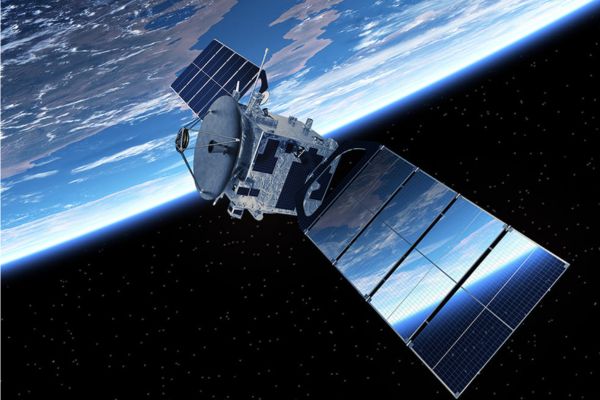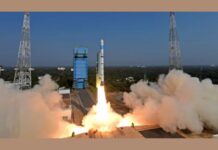The global space technology market size was exhibited at USD 476.62 billion in 2024 and is projected to surpass USD 1,012.13 billion by 2034 with a notable CAGR of 7.86% from 2025 to 2034
The space technology market is experiencing rapid growth, driven by increasing investments in satellite development, space exploration missions, and commercial space ventures. Key drivers include rising demand for satellite-based communication, Earth observation services, and global navigation systems across industries such as defense, agriculture, meteorology, and transportation. The entry of private players like SpaceX, Blue Origin, and Rocket Lab has intensified competition and innovation, leading to cost reductions in launch services and satellite manufacturing. Additionally, advancements in reusable launch vehicles, miniaturized satellite systems, and AI integration are revolutionizing the sector. Governments worldwide are also expanding space programs and forming international collaborations to address both strategic and scientific objectives. As a result, the global space technology market is poised for sustained expansion, with emerging economies increasingly participating in this high-tech frontier.
Space Technology Market Key Points
- North America dominated the global market with the largest market share of 55.84% in 2024.
- Asia Pacific is expected to expand at the fastest CAGR of 9.59% between 2025 and 2034.
- By type, the space vehicles segment has held a major market share of 70.77% in 2024.
- By end use, in 2024, the commercial segment dominated the market with the largest market share of 68.41% in 2024.
- By application, the navigation and mapping segment led the market with a maximum market share of 22.99% in 2024.
Impact of Artificial Intelligence (AI) Space Technology Market
Artificial Intelligence (AI) is revolutionizing the space technology market by improving efficiency, autonomy, and data analysis capabilities. It is enabling autonomous control in satellite operations, supporting predictive maintenance, and processing vast amounts of satellite imagery for environmental monitoring. AI powers autonomous navigation systems in planetary rovers, reducing development time and costs. It also aids in mission planning and spacecraft design by simulating performance under various conditions. AI is also transforming astronomical research by filtering noise from deep-space signals and identifying new celestial bodies. As commercial and defense sectors expand their space initiatives, AI is becoming a strategic asset, enabling smarter surveillance systems, space traffic management, and secure communication networks.
Space Technology Market Regional Insights
North America: The Global Leader with Deep-Rooted Infrastructure
North America continues to dominate the space technology market, holding a commanding 55.84% share in 2024, valued at USD 266.15 billion. By 2034, it is projected to reach USD 548.07 billion, growing at a solid CAGR of 7.53%. A major contributor to this dominance is the United States, which alone accounts for USD 237.62 billion in 2024. The U.S. is home to not only government agencies like NASA but also disruptive private players such as SpaceX, Blue Origin, and Northrop Grumman. The region’s mature launch infrastructure, regulatory support, and ambitious programs around moon and Mars missions position it to maintain leadership.
- North America’s strength lies in its ability to blend public vision with private innovation. SpaceX’s breakthroughs in reusability and the Artemis missions are just the beginning — this region will likely lead in lunar infrastructure and space-based economy platforms over the next decade.
Europe: Strategic and Cooperative Growth
Europe represents the second-largest regional market, valued at USD 98.39 billion in 2024 and expected to reach USD 193.65 billion by 2034, growing at a CAGR of 7.04%. Its 20.64% market share reflects the collective efforts of the European Space Agency (ESA) and national programs from countries like France, Germany, and Italy. The continent focuses heavily on Earth observation, satellite navigation, and space sustainability. While Europe faces pressure from agile private competitors elsewhere, it compensates with cohesive international partnerships and advanced engineering capabilities.
- Europe may not match the pace of SpaceX-style disruption, but its focus on long-term sustainability and scientific exploration makes it a stable and vital pillar of the global space economy. Its cooperative nature also allows it to leverage broader geopolitical advantages.
Asia Pacific: The Fastest-Growing Contender
Asia Pacific is the rising star of the space technology market. From USD 85.92 billion in 2024, the market is poised to grow to USD 214.07 billion by 2034, achieving the highest CAGR at 9.59%. The region holds 18.03% of the market and is powered by the ambitions of China, India, Japan, and emerging nations like South Korea and Australia. China’s long-term space station ambitions and lunar programs, combined with India’s cost-effective Mars and Moon missions, are redefining global competitiveness.
- What’s exciting here is the rapid rise of private space startups in countries like India — driven by ISRO’s liberalized policies. Asia Pacific’s blend of affordability, government support, and growing venture capital makes it the one to watch closely.
Latin America:
Latin America’s space technology market is relatively small, valued at USD 10.79 billion in 2024, with growth projected to USD 23.68 billion by 2034 at a CAGR of 8.22%. Despite a modest 2.26% market share, the region is building momentum. Countries like Brazil, Argentina, and Mexico are investing in satellite technologies for agriculture, disaster monitoring, and communications, often in partnership with more developed space nations.
Middle East & Africa:
The Middle East & Africa market was valued at USD 15.37 billion in 2024 and is expected to grow to USD 32.67 billion by 2034, at a CAGR of 7.87%, with a 3.22% market share. The UAE is a standout player with its Mars mission and lunar ambitions, while countries like Saudi Arabia, South Africa, and Nigeria are making strides in satellite launches and education-focused programs. The region is turning to space for economic diversification, navigation, and climate monitoring.
My thoughts: This region is undergoing a quiet revolution. The UAE’s space narrative is both symbolic and strategic. If more countries in the region invest in talent and infrastructure, it could become a surprise growth hub by 2040.
Type Analysis
The space vehicles segment encompasses a wide range of manned and unmanned crafts, such as crewed spacecraft, satellites, rovers, and probes that are used for various space exploration missions. As private companies and national space agencies increase their activities in orbit and beyond, the demand for space vehicles is growing rapidly, driven by space tourism, satellite launches, and planetary exploration. Meanwhile, space stations, such as the International Space Station (ISS), serve as long-duration orbital laboratories for scientific experiments, international collaboration, and technological demonstrations. With the rise of commercial interests, newer space stations are being developed for tourism and research by private entities.
The orbital launch vehicles segment refers to rockets that transport payloads like satellites or cargo into space. This market is seeing a boom due to growing satellite constellations, cost-effective launch solutions, and the popularity of reusable rockets pioneered by SpaceX and others. On the other hand, deep-space communication systems are crucial for enabling data transfer across vast distances in space, especially for missions targeting the Moon, Mars, or asteroids. Technologies such as optical communication and high-frequency radio systems are key developments in this space.
Space Technology Market Revenue, By Type 2022-2024 (USD Billion)
| Type | 2022 | 2023 | 2024 |
| Space Vehicles | 277.42 | 295.77 | 315.63 |
| Space Stations | 37.77 | 40.55 | 43.57 |
| Orbital Launch Vehicles | 51.62 | 55.30 | 59.29 |
| Deep-space communication | 15.10 | 16.18 | 17.35 |
| In-space Propulsion | 23.42 | 24.97 | 26.65 |
| Others | 12.45 | 13.26 | 14.13 |
End-use Analysis
In terms of end-use, government space agencies play a central role in shaping the market. Agencies like NASA, ESA, and ISRO drive demand for satellites, launch services, and infrastructure for purposes such as national development, scientific research, disaster monitoring, and geopolitical strategy. Their initiatives often serve as the foundation for technological advancement and commercial collaboration. The military segment, meanwhile, has emerged as a key driver of space technology with a focus on surveillance, secure communications, and defense applications. Space-based intelligence and reconnaissance systems are vital for modern warfare and national security.
The commercial sector is experiencing significant expansion, as companies across telecom, logistics, agriculture, and analytics leverage space-based services. Players like SpaceX, Blue Origin, and OneWeb are transforming the sector by offering satellite broadband, launch services, and even space tourism. As space becomes more accessible, the commercial sector is expected to be the dominant growth engine, fostering innovation and driving costs down through competition.
Space Technology Market Revenue, By Type 2022-2024 (USD Billion)
| End Use | 2022 | 2023 | 2024 |
| Government | 284.66 | 304.52 | 326.07 |
| Military | 44.82 | 47.48 | 50.34 |
| Commercial | 88.29 | 94.02 | 100.21 |
Application Analysis
In terms of application, navigation and mapping via satellite systems like GPS and Galileo are foundational to transportation, agriculture, logistics, and personal mobility. Satellite-based navigation is integral to modern economies, with applications ranging from precision farming to autonomous vehicles. Meteorology, or weather forecasting, relies heavily on satellite data to monitor atmospheric conditions, predict storms, and track climate patterns, which is increasingly critical due to the effects of climate change.
Disaster management uses satellites for early warning systems, monitoring floods, wildfires, and earthquakes, and coordinating emergency response. Real-time imaging and communication are essential for saving lives during natural calamities. Satellite communication, including VSAT networks and global broadcasting, supports telecom networks, rural connectivity, and broadcasting, while satellite television remains a widespread medium for content delivery, especially in remote regions.
Remote sensing allows high-resolution imaging of the Earth for applications in agriculture, urban planning, mining, and environmental monitoring. It plays a pivotal role in understanding changes in land use, vegetation, and water bodies. Science and engineering applications involve research conducted in microgravity or using space-based instruments, advancing our understanding of materials, biology, and physics. Similarly, Earth observation supports sustainability and policy-making by monitoring deforestation, ocean currents, and glaciers.
Space Technology Market Top Companies
- Airbus SE
- Astra Space Inc.
- Ball Corporation
- Beijing Commsat Technology Development Co. Ltd.
- Blue Origin LLC
- Boeing
- China Aerospace Science and Technology Corporation
- General Dynamics Corporation
- Hedron
- Hindustan Aeronautics Limited
- Honeywell International Inc.
- ICEYE
Space Technology Market Recent Activities
Amazon’s Project Kuiper: Amazon is set to launch its satellite internet network, Project Kuiper, with the deployment of 27 satellites aboard a United Launch Alliance Atlas V rocket from Cape Canaveral. This initiative aims to challenge SpaceX’s Starlink by eventually deploying approximately 3,200 satellites to provide global broadband services.
China’s Qianfan Constellation: China has initiated the Qianfan project, also known as the Spacesail Constellation or G60 Starlink, planning to deploy over 15,000 low-Earth orbit satellites to provide worldwide internet coverage. The project commenced in 2024, with multiple satellite launches already completed.
European Union’s IRIS²: The EU is developing IRIS² (Infrastructure for Resilience, Interconnectivity and Security by Satellite), a multi-orbit satellite internet constellation expected to consist of 264 satellites in low Earth orbit and 18 in medium Earth orbit. The project aims to provide secure communications and broadband services, with initial government services anticipated to start in 2030.
India’s SSLV Privatization: The Indian Space Research Organisation (ISRO) is in the process of privatizing the production of its Small Satellite Launch Vehicle (SSLV). Finalists in this bid include Adani Group, Bharat Dynamics Limited, and Hindustan Aeronautics Limited. This move aims to bolster India’s commercial space sector and increase its share in the global satellite launch market

















